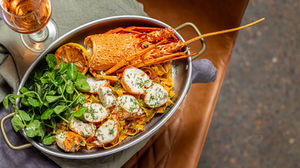Live the Rosé Life… All Year Round
- Quentin Von Essen
- Sep 16, 2022
- 3 min read

Great to look at and even better to taste, but it was not all that long ago when the only people drinking Rosé were either French or tourists enjoying the sun-kissed lifestyle in southern France.
Today people can’t seem to get enough of this trendy tipple, and it has become one of the fastest-growing wine categories in the last five years, with the biggest markets being the US, France, South Africa, Denmark, and Australia.
Some wine experts credit this shift in popularity to the discovery of the chic, European style of Rosé – those pale, fresh, delicate wines coming from areas like the Côtes de Provence in the South of France. These elegant French expressions allowed Rosé to shed its dull reputation, and suddenly this trendy drop was being enjoyed everywhere, from the beach houses in the Hamptons to pool parties in the Hollywood Hills.
However, Rosé is not just the trendy wine of the 21st century – it is also one of the oldest and yet most modern of wines. The origins of Rosé winemaking can be traced back to ancient Greece, when much of the red wine produced was pale red. By mid-100 B.C, the Romans had popularised darker red wines in Europe, but Rosé wine remained popular in parts of France – most notably, Provincia Romana, which is today’s Provence region. They take it very seriously over there, and some of the world’s finest Rosés come from this region – often referred to as the Rosé capital of the world.
Nowadays, almost all the world’s wine-producing regions make Rosé wine. The first and arguably, most important Rosé producer is France, where it is predominantly found in the southern region of Tavel, Provence and the Loire Valley in Anjou. Other important regions are Piedmont in Italy, Rioja in Spain and Styria in Austria.
Rosé is produced in a comparable manner to how red wine is produced, but the red grape skins are removed earlier during fermentation. Since there are no pink grapes, Rose’s pinkish hue comes from red grapes that are in contact with the wine mixture for less time than red wine.
For this wine, colour is essential and is a significant aspect of its appeal. It is impossible to define the “correct” colour of Rosé wine, which can be a veritable rainbow of different shades of pink – from pale copper, pastel pink, mauve blushes and magenta, through to apricot and even orange. The vast range of colours depends on the grape used, the richness of the grape’s phenolic compounds and the winemaking techniques used, which include the length of time the grape skins have been in contact with the grape juice. And when it comes to the taste, you can expect sweet, savoury, dry, textural, smooth, light, creamy, heavy – you name it!
Australia’s fresh and vibrant Rosés are produced from red grape varieties such as Shiraz and Grenache, with only minimal contact on skins to give the wines their signature ‘blush.’ However, other varieties like Tempranillo, Nebbiolo, Sangiovese, Cabernet Sauvignon and Pinot Noir also make delicious versions of this wine.
The wonderful thing about Rosé is that it can be enjoyed all year round. But it is really in its prime in the warmer months. After all, is there anything more magical than a summer picnic or BBQ with friends, delicious food and a glass of gorgeous pink in your hand?
When it comes to food, it is the most versatile wine for food pairing, displaying the freshness of white wine combined with the structure and heft of a red. As a fantastic food wine, it can be paired with various foods and flavours and manages spices and heat very well. Rosé is excellent alongside salads, antipasto platters, fish dishes or even your favourite curry and is the perfect accompaniment to soft goat cheese.
Rosé usually has a delicate flavour and a balance of sweetness and acidity that make it a refreshing palate-cleansing drink. Best served young and at a chilled temperature.
If the world looks better to you through Rosé coloured glasses, there are plenty of delicious Rosés in the Hunter to try – and you can enjoy them all year long.
View our Top 6 Rosé Wines of the Hunter Valley











































































































